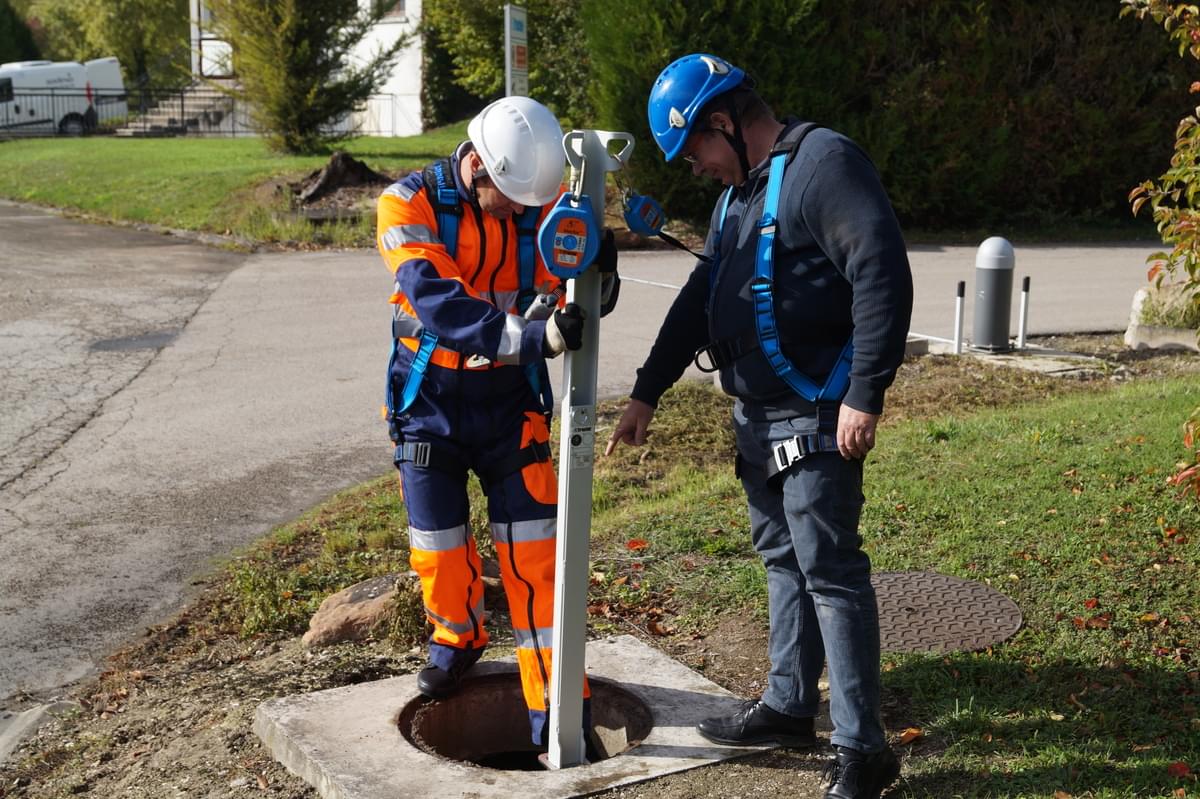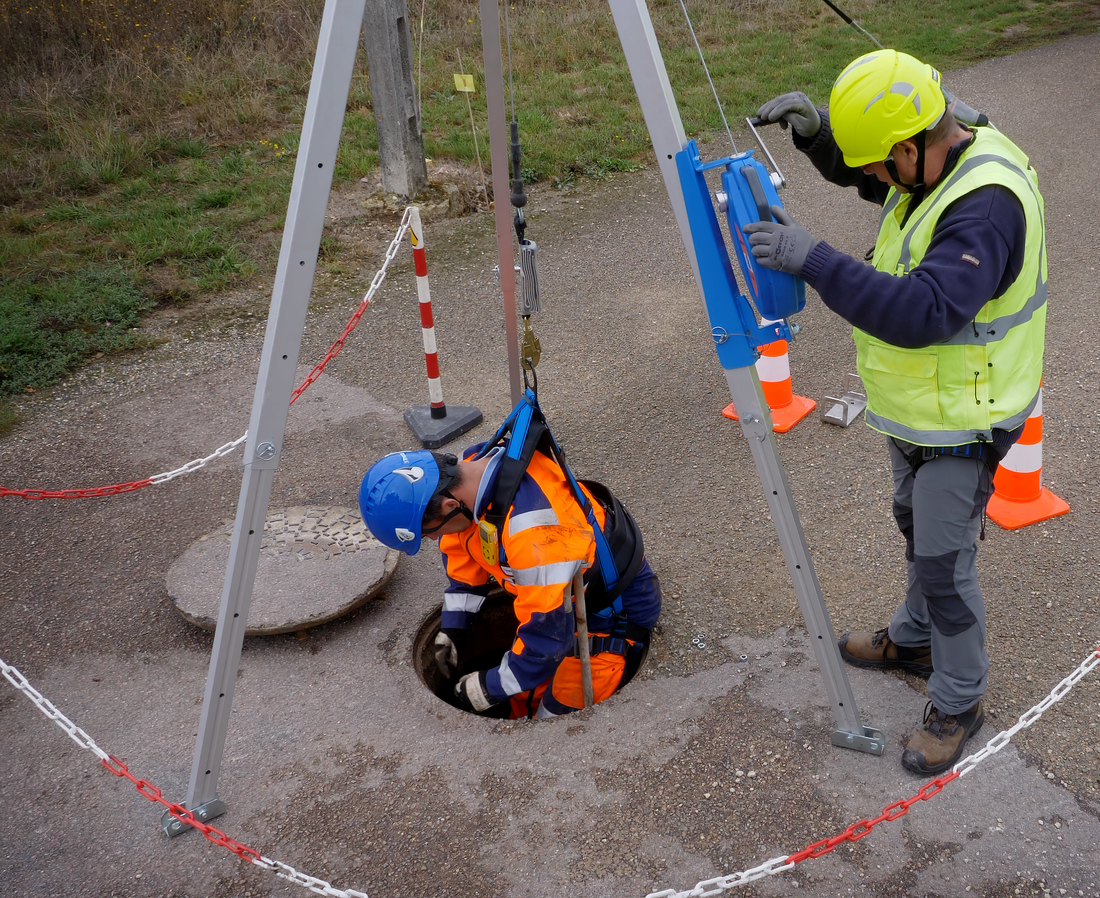Work in confined spaces involves many risks, and among them, falls from height are among the most serious.
Whether it's a silo, a tank, a well, or an underground tunnel, each intervention requires careful preparation and the implementation of strict safety measures. Workers must be equipped with appropriate personal protective equipment, such as safety harnesses and fall arrest systems, and must follow specific procedures to minimize risks. Ongoing training and awareness of potential hazards are also crucial to ensuring everyone's safety.
Discover the 5 essential golden rules to prevent falls in confined spaces, along with best practices.
1. Identify and assess risks before any intervention in a Confined Space
Before entering a confined space, it is crucial to assess potential hazards to ensure the safety of workers. This assessment includes several essential steps:
- Analysis of environment-specific risks: It is important to identify hazards such as lack of oxygen, presence of toxic gases, slippery surfaces, obstacles, and other dangerous conditions. This analysis allows for the implementation of preventive measures tailored to each situation.
- Verification of access points and ladders: Before any intervention, it is necessary to ensure that access points and ladders are in good condition and secure. This includes checking the stability of ladders, the strength of anchor points, and the absence of any elements that could obstruct access or exit from the confined space.
- Estimation of potential fall height: It is crucial to measure the potential fall height in order to determine the necessary personal protective equipment, such as safety harnesses and fall arrest systems. This estimation helps prevent serious falls and ensures the safety of workers.
- Presence or absence of collective protections (guardrails, nets, work platforms): It is essential to check whether collective protections, such as guardrails, safety nets, or work platforms, are in place. These devices play a crucial role in fall prevention and protecting workers in confined spaces.
By following these steps, the risks associated with work in confined spaces can be significantly reduced, thereby ensuring the safety and health of workers.
Best practices:
- Create a work permit before any operation.
- Perform a visual inspection and stability test of access structures.
- Consult the current regulations and applicable safety standards.
2. Use Collective Protective Equipment (CPE)
Collective protective equipment (CPE) plays a crucial role as the first line of defense against falls in confined spaces. They are designed to protect all workers by reducing fall risks and ensuring a safer working environment.
Here are some commonly used CPE examples:
- Rigid guardrails around openings: These devices are installed around openings and edges to prevent workers from accidentally falling. They provide a solid and reliable physical barrier, thereby reducing fall risks.
- Temporary safety barriers: Used during temporary work, these barriers are easy to install and remove. They help delineate hazardous areas and protect workers from potential falls.
- Fall arrest nets placed under work areas: These nets are installed beneath elevated work areas to catch workers in case of a fall. They provide additional protection by cushioning the fall and reducing the risk of serious injuries.
- Safe walkways and platforms: These structures allow workers to move safely within confined spaces. They are designed to be stable and slip-resistant, thus minimizing fall risks.
By using these collective protective equipment, companies can create a safer working environment and significantly reduce the risks of falls and accidents. It is essential to ensure that these devices are properly installed and maintained to guarantee their maximum effectiveness.
Best practices:
- Always prioritize collective solutions before using personal protective equipment.
- Check the strength of guardrails and their compliance with safety standards.
- Install warning signs and clear signage.
3. Equip yourself with a suitable safety harness and fall arrest system
When collective protective measures are not sufficient to ensure the safety of workers in confined spaces, wearing personal protective equipment (PPE) for fall protection becomes essential. These equipment are designed to minimize fall risks and protect workers in case of an accident.
Here are the essential elements to consider:
- Fall arrest harness: The fall arrest harness must comply with EN 361 standards and be adjusted to the worker's body shape. It is crucial that the harness is properly fitted to provide optimal protection and prevent any risk of slippage or improper fastening.
- Lanyard with energy absorber or automatic retractable fall arrest system: The lanyard must be equipped with an energy absorber to limit the impact in case of a fall. This absorber reduces the impact force on the worker's body, thereby decreasing the risk of serious injuries.
- Certified anchor point (EN 795): The anchor point, compliant with EN 795 standards, is used to secure the lanyard. It is essential that the anchor is securely installed and certified to ensure the safety of the fall protection system.
- Recovery system (winch, automatic retractable fall arrest system with integrated recovery winch): A recovery system, such as a winch or an automatic retractable fall arrest system with an integrated recovery winch, allows for lifting a worker in case of a fall or distress. This system is crucial for ensuring a quick and effective intervention in case of an emergency, saving lives and reducing the risk of complications.
By using these personal protective equipment, workers can be better protected against fall risks in confined spaces. It is important to ensure that each element is used and maintained properly to guarantee their maximum effectiveness. Training and raising awareness among workers on how to use this equipment is also essential to prevent accidents and ensure the safety of everyone.

Best practices:
- Always check the condition of PPE before each use.
- Train workers in the use of equipment.
- Never use a damaged harness or one whose validity date has expired.
4. Ensure constant monitoring and effective communication
Ensuring constant monitoring and effective communication is essential to guarantee the safety of workers in confined spaces. A worker should never intervene alone in a confined space, as this significantly increases the risks in case of a problem. The presence of a supervisor and the use of communication systems allow for a quick and efficient response in case of an incident.
Monitoring methods:
- Presence of a supervisor outside the confined space: A supervisor must be present outside the confined space to monitor working conditions and intervene if necessary. This supervisor plays a crucial role in ensuring the safety of workers and coordinating rescue actions if needed.
- Use of a radio communication system: Radio communication systems allow workers in confined spaces to stay in constant contact with the supervisor and other team members. These systems facilitate the rapid transmission of information and coordination of interventions in case of a problem.
- Cameras or connected sensors to monitor the worker in real-time: Installing cameras or connected sensors allows for real-time tracking of workers' movements and working conditions. These devices provide continuous monitoring and enable quick detection of any incident or anomaly, thus facilitating a quick and effective response.
By implementing these monitoring and communication methods, companies can ensure optimal responsiveness in case of a problem and ensure the safety of workers in confined spaces. It is also important to train workers in the use of these systems and raise awareness about the importance of monitoring and communication to prevent accidents.
Best practices:
- The supervisor must be trained in emergency response.
- An evacuation plan must be pre-established and known to all.
- Regular tests of communication systems must be conducted.
5. Implement an operational emergency plan
Even with all precautions, an incident can occur during interventions in confined spaces. Therefore, it is essential to have a clear and effective emergency plan to ensure the safety of workers. This plan must be well-structured and regularly updated to meet the specific needs of each situation.
This plan should include:
- The location of emergency exits: Workers must be aware of the nearest exit points and the routes to take in case of an emergency. These exits should be clearly marked and easily accessible to allow for a rapid evacuation.
- The presence of a rescue team ready to intervene: This team should consist of members trained in rescue techniques and capable of responding quickly in case of an incident. Their role is to coordinate rescue operations and ensure the safety of workers.
- Rescue equipment available and in good condition: This includes equipment such as winches to lift workers in case of a fall, stretchers to transport the injured, oxygen bottles for situations with a lack of air, and gas detectors to monitor the presence of hazardous substances. This equipment must be regularly inspected and maintained to ensure its effectiveness.
- Regular first aid training for teams: Workers should be trained to react in emergencies, use rescue equipment, and administer first aid. Regular training sessions help maintain a high level of competence and vigilance among the teams.

Best practices:
- Conduct regular evacuation drills.
- Ensure that all workers are familiar with emergency procedures.
- Keep emergency equipment in good condition and easily accessible.
By implementing an operational emergency plan, companies can ensure a quick and effective response in case of an incident, thereby protecting the health and safety of workers in confined spaces.
Conclusion fall hazard prevention in confined spaces
Fall prevention in confined spaces relies on thorough preparation and strict adherence to safety protocols. Identifying the specific risks associated with each environment, the proper use of collective protective equipment (CPE) and personal protective equipment (PPE), as well as continuous monitoring of working conditions, are essential elements to ensure the safety of workers. Furthermore, it is crucial to have an appropriate emergency plan in place to respond quickly in case of an incident.
To ensure effective prevention, it is essential to distribute this memo to all personnel and regularly raise awareness about potential hazards and best practices to follow. Organizing training and awareness sessions helps maintain a high level of vigilance and skill among workers, thereby reducing the risk of accidents.
By adopting these measures, you will contribute to creating a safer working environment and protecting the health and safety of all personnel working in confined spaces.